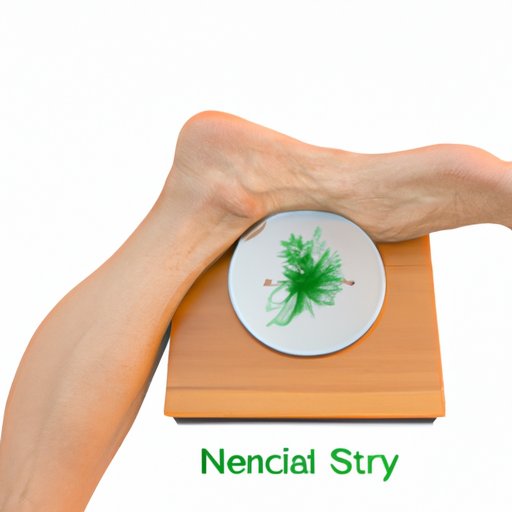
Introduction
Sciatica is a common condition that affects the sciatic nerve, which is the longest nerve in the body, running from the lower back down to the legs. This type of pain is commonly caused by a herniated disc, spinal stenosis, or an injury to the back. Sciatic nerve pain varies in intensity, and can range from a mild ache to a sharp, burning sensation. It can also be accompanied by tingling, numbness, and weakness in the legs.
If you have sciatic nerve pain, it is important to seek treatment and manage your symptoms. Ignoring the discomfort can lead to more severe pain and can negatively impact your quality of life.
Natural Treatments for Sciatic Nerve Pain: Holistic Methods for Relief
Natural treatments can serve as effective alternatives to traditional medication. The benefits of natural remedies are that they have fewer side effects and are often less harsh on the body.
Heat therapy can provide relief by increasing blood flow, reducing inflammation, and relaxing muscles. Try applying a hot compress or using a heating pad on the affected area for 20 minutes at a time.
Essential oils such as peppermint, lavender, and eucalyptus can help soothe the pain. Simply apply a few drops to the affected area and gently massage. Herbal supplements such as turmeric, ginger, and devil’s claw can also alleviate pain and inflammation.
It is important to use natural treatments safely by following guidelines and consulting with a healthcare provider. Avoid using certain natural remedies if you are taking medications or have underlying medical conditions.
The Most Effective Stretches for Sciatic Nerve Pain: A Step-By-Step Guide
Stretching can improve mobility and reduce pain associated with sciatic nerve pain. It can also prevent future occurrences.
Performing gentle stretches and exercises can help loosen up muscles and promote blood flow to the affected area.
A few stretches to try include the seated spinal twist, standing hamstring stretch, and the pigeon pose. Before trying any new stretches, make sure to speak to your healthcare provider to determine which stretches are best for you and how to properly execute them.
In-Depth Guide to Pain Medication Options for Sciatic Nerve Pain
Pain medications can provide temporary relief from sciatic nerve pain. There are various options available over the counter (OTC) or by prescription.
The most common types of OTC pain medications include nonsteroidal anti-inflammatory drugs (NSAIDs) such as ibuprofen and acetaminophen (Tylenol). Prescription medications such as muscle relaxants and opioids may be prescribed by a healthcare provider. However, it is important to be aware of the potential risks and side effects associated with medication use. Always speak to your provider before taking any medication, as they can help you determine the best option for you.
How to Prevent Sciatic Nerve Pain: Tips for Avoiding Future Discomfort
Prevention is key when it comes to avoiding future episodes of sciatic nerve pain. Knowing the common causes of this type of pain and taking steps to prevent it can save you from unnecessary discomfort.
Improving posture and ergonomics is crucial in preventing sciatic nerve pain. Avoid sitting or standing in one position for extended periods of time, and pay attention to your posture when lifting heavy objects or engaging in strenuous activities. Strengthening your core muscles and maintaining a healthy weight can also significantly reduce the risk of sciatic nerve pain.
Alternative Therapies for Sciatic Nerve Pain: Acupuncture, Chiropractic, and More
In addition to natural remedies and stretching, alternative therapies can also serve as effective treatment options. Acupuncture, chiropractic, and massage therapy are just a few of the many alternative therapies available.
Acupuncture involves inserting needles into specific points on the body to stimulate energy flow and promote healing. Chiropractic care focuses on restoring the alignment of the spine and relieving musculoskeletal pain. Massage therapy can help reduce muscle tension and improve circulation, which can alleviate pain and promote relaxation.
As with any treatment option, it is important to discuss potential risks and benefits with a healthcare provider and ensure that the practitioner providing the treatment is fully licensed and qualified.
Exercises to Strengthen and Relieve Sciatic Nerve Pain: A Targeted Workout Routine
Exercising can be an effective way of strengthening the muscles supporting the spine and reducing the risk of sciatic nerve pain.
A targeted workout routine can include exercises such as pelvic tilts, bridges, and leg lifts. These exercises are designed to strengthen the muscles in the lower back, core, and legs. Gradually increasing the intensity and frequency of exercise can help prevent future occurrences of sciatic nerve pain.
Conclusion
Suffering from sciatic nerve pain can be debilitating and negatively impact your quality of life. Seeking proper treatment and managing your symptoms can help you live a pain-free lifestyle. Using natural remedies, performing targeted stretches and exercises, and incorporating alternative therapies can provide relief. Always consult with a healthcare provider to determine the best course of treatment based on your unique needs and condition.





